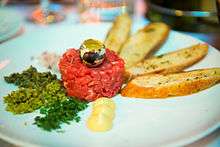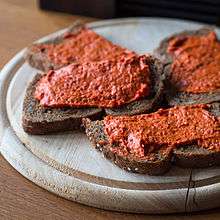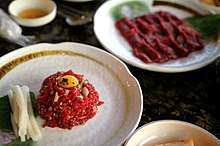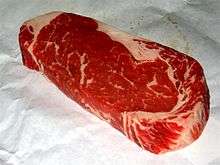Steak tartare
 Beef steak tartare with raw egg yolk | |
| Course | Appetizer |
|---|---|
| Main ingredients | Raw beef |
| Variations | Tartare aller-retour |

Steak tartare is a meat dish made from raw ground meat (beef[1][2] or horsemeat[3]). It is usually served with onions, capers, pepper and Worcestershire sauce, and other seasonings, often presented to the diner separately, to be added to taste. It is often served with a raw egg yolk, and often on rye bread.
The name tartare is sometimes generalized to other raw meat or fish dishes.
A less-common version in France is tartare aller-retour, a mound of mostly raw ground meat that is lightly seared on both sides.
History
The idea of eating raw meat was first noted in Slavic regions. In the thirteenth century, Joinville noted that Tarters tenderized their meat beneath their saddles.[4]. In 1660, the French engineer Guillaume Le Vasseur de Beauplan wrote of the Cossacks (in the book Description d'Ukranie, qui sont plusieurs provinces du Royaume de Pologne, contenues depuis les confins de la Moscovie, jusques aux limites de la Transylvanie ; ensemble leurs mœurs, façons de vivres, et de faire la guerre. Rouen,):
"They separate the [horse meat] into quarters and take three of these quarters to their friends who have none, and only keep for themselves a rear quarter, which they cut into the biggest rounds they can at the meatiest part, and only one or two inches thick., put it on the back of their horse which they saddle, bleeding it as much as they can, then mount, run for two or three hours because the whole army goes at the same cadence: after they dismount, take off the saddle and turn over their round of meat, and collect the horse's foam with a finger, and moisten this food with it so that it doesn't dry out too much; this done they saddle up again and tie it tight as before, again riding two or three hours, and then the meat is cooked to their taste."
"Ils la separent par quartiers & en prestent trois de ces quartiers à leurs camarades qui n'en ont point, & ne retiennent pour eux qu'vn quartier de derriere, lequel ils couppent par rouelles les plus grandes qu'ils peuuent à l'endroit le plus charnu, & espais seulement d'vn à deux poulces, le mettent sur le dos de leur cheual qu'ils sellent dessus, le sanglant le plus fort qu'ils peuuent, puis montent à cheual, courent deux ou trois heures en chemin faisant, car toute l'armée va de mesme cadence : apres ils redessendent, le desellent & retournent leur roüelle de chair, & auec le doigt recueillent l'escume du cheual, & en arrousent ces mets de peur qu'ils ne se desseichent trop: cela fait ils le resellent & ressenglent bien fort comme deuant, recourant de nouueau deux ou trois heures, & alors la chair est cuite à leur gré"
However these early examples are not related in any direct way to modern steak tartare. The first reference (to "tartar steak") in fact seems to come from America in 1889. In the early twentieth century what is now generally known as "steak tartare" was called steack à l'Americaine. Steak tartare was a variation on that dish; the 1921 edition of Escoffier's Le Guide Culinaire defines it as steack à l'Americaine made without egg yolk, served with tartar sauce on the side.
The current name is a shortening of the French original "à la tartare", literally meaning "served with tartar sauce", a dish popular in the 19th and early 20th centuries.[5][6]
Over time, the distinction between steack à l'Americaine and its variant disappeared. The 1938 edition of Larousse Gastronomique describes steak tartare as raw ground beef served with a raw egg yolk, without any mention of tartar sauce.
Formerly, it was called "Tartar steak".[7]
Although the word "tartare" seems to suggest relation with the Tatar people, there is no evidence that steak tartare originated from or is inspired by Tatar cuisine.[8]
"À la tartare" or simply "tartare" still means "served with tartar sauce" for some dishes, mostly fried fish.[9] The name "tartare" is now sometimes applied to other meats or fish, such as tuna tartare, introduced in 1975 by the restaurant Le Duc in Paris.[10]
Health concerns
Health concerns have reduced the popularity of this meat dish in some parts of the world because of the danger of contamination by bacteria and parasites[11] such as Toxoplasma gondii and Taenia saginata.
Bacteria
When basic hygienic rules are followed and fresh meat is used, the risk of bacterial infection is low.[12] Even when these provisions are met, it is nonetheless not recommended for people who have a weakened immune system or a chronic illness, as these individuals are at a greater risk of infection from E. coli and/or Salmonella.
Parasites
Toxoplasma gondii is a parasite that may be found in raw or undercooked meat.[13] Cultural differences in raw meat consumption are thought to be a cause of regional variation in the prevalence of toxoplasma infection (ranging from around 55% in France down to 10% in the United Kingdom).[14] Due to the risk of congenital toxoplasmosis in the fetus, pregnant women are advised not to eat raw meat.[15] Latent toxoplasmosis in adults, though not as harmful as congenital toxoplasmosis, has been associated with psychological effects[16] and lower IQ[17] in some studies.
Regional variations
Europe


Steak tartare is found in many European cuisines.
The Belgian version, filet américain (préparé), is generally made with mayonnaise and seasoned with capers and fresh herbs. It was formerly made of horse meat. It is usually served with french fries.[18]
In the Czech republic, steak tartare (tatarský biftek) is found in most restaurants. The meat is ground lean sirloin and has a raw egg yolk in a dimple in the middle. The meat can be premixed with herbs and spices, but usually the customer is given spices and condiments to add to taste. Steak tartare is typically served with fried bread (topinka) and raw garlic cloves for rubbing on the toast.
A variant of steak tartare is also present in Danish smørrebrød, where it is served on rugbrød (rye bread) with assorted toppings. In Sweden, steak tartare, råbiff, is usually served with raw egg yolk, raw onions, diced pickled beetroot and capers. In Finland, tartarpihvi is served with raw egg yolk, raw onions, pickled and salted cucumbers and capers. Variations of the dish include dressing with buttermilk sauce and salmon roe. The (European) Russian version can include pickled and salted mushrooms and toasted white bread.
North America
In Wisconsin, it is quite popular among the descendants of German immigrants, using raw ground sirloin, rye bread as in Germany, pepper, onions, and an egg. It is popularly known as the "cannibal sandwich" among many Wisconsin residents.[19][20]
South America
Chilean cuisine features a dish of prepared raw beef called crudos.
In southern Brazil, influenced by German immigrants, it is known as Hackepeter or Carne de Onça in Curitiba where this dish is very common and served covered with chives.[21]
Africa
Ethiopians have long eaten a dish of raw, minced beef called kitfo.[22]
See also
- Basturma - a real tatars dish
- Basashi – Japan, horse meat
- Carpaccio – Italy, beef
- Çiğ köfte – Turkey
- Crudos – Chile
- Gored gored – Ethiopia
- Hamburger – United States, beef
- Kibbeh nayyeh – Levant
- Kitfo – Ethiopia
- Larb
- List of beef dishes
- List of steak dishes
- Mett or hackepeter – Germany, pork
- Salmon tartare
- Yukhoe – Korea
References
- ↑ Waxman, Jonathan; Steele, Tom; Flay, Bobby; Kernick, John (2007). A Great American Cook: Recipes from the Home Kitchen of One of Our Most Influential Chefs. Houghton Mifflin Harcourt. ISBN 0-618-65852-1.
- ↑ Raymond Sokolov, The Cook's Canon, 2003, ISBN 0-06-008390-5, p. 183 at Google Books
- ↑ Lonely Planet, Food Lover's Guide to the World: Experience the Great Global Cuisines, 2014, p. 97
- ↑ Jim Chevallier, A History of the Food of Paris: From Roast Mammoth to Steak Frites, 2018, ISBN 1442272821, pp. 190-191
- ↑ Sokolov, Raymond (2004). How to Cook Revised Edition: An Easy and Imaginative Guide for the Beginner. New York, NY (USA): Harper Collins. pp. 41–42. ISBN 0-06-008391-3. Retrieved 3 June 2012.
- ↑ Albert Jack, What Caesar Did for My Salad: Not to Mention the Earl's Sandwich, Pavlova's Meringue and Other Curious Stories Behind Our Favourite Food, 2010, ISBN 1-84614-254-7, p. 141 at Google Books
- ↑ ""tartar steak" - Google Search". www.google.com. Retrieved 27 March 2018.
- ↑ Craig J. Smith (6 April 2005). "The Raw Truth: Don't Blame the Mongols (or Their Horses)". New York Times. Archived from the original on 27 February 2013. Retrieved 3 June 2012.
- ↑ Prosper Montagné, Charlotte Snyder Turgeon, The new Larousse gastronomique: the encyclopedia of food, wine & cookery, 1977, p. 334
- ↑ Gael Greene, "Le Colisee Thrown to the Lions", New York (magazine) November 3, 1975, p. 101
- ↑ "Fresh Meat for Steak Tartar". Streetdirectory.com. Archived from the original on 2013-08-03. Retrieved 2013-12-14.
- ↑ "Archived copy" (PDF). Archived (PDF) from the original on 2011-07-22. Retrieved 2011-11-15.
- ↑ "Toxoplasmosis | ANSES - Agence nationale de sécurité sanitaire de l'alimentation, de l'environnement et du travail". Anses.fr. Archived from the original on 2013-10-21. Retrieved 2013-12-14.
- ↑ "Sources of toxoplasma infection in pregnant women: European multicentre case-control studyCommentary: Congenital toxoplasmosis—further thought for food". BMJ. Archived from the original on 2014-01-31. Retrieved 2013-12-14.
- ↑ "Archived copy" (PDF). Archived (PDF) from the original on 2015-04-16. Retrieved 2013-04-29.
- ↑ Dickerson, F.; Stallings, C.; Origoni, A.; Vaughan, C.; Katsafanas, E.; Khushalani, S.; Yolken, R. (2013). "Antibodies toToxoplasma gondiiin individuals with mania". Bipolar Disorders. 16: 129–136. doi:10.1111/bdi.12123. PMID 24102676.
- ↑ Flegr, J.; Preiss, M.; Klose, J.; Havlícek, J.; Vitáková, M.; Kodym, P. (2003). "Decreased level of psychobiological factor novelty seeking and lower intelligence in men latently infected with the protozoan parasite Toxoplasma gondii Dopamine, a missing link between schizophrenia and toxoplasmosis?". Biological Psychology. 63 (3): 253–268. doi:10.1016/S0301-0511(03)00075-9. PMID 12853170.
- ↑ Jacques Mercier, Au coeur des mots: Les rubriques de Monsieur Dico, p. 216
- ↑ Whitefield, Paul (6 December 2013). "'War on Christmas' expands to 'war on cannibal sandwich' in Wisconsin". Archived from the original on 25 June 2015. Retrieved 27 March 2018 – via LA Times.
- ↑ Barry Adams, Wisconsin State Journal. "On Wisconsin: Raw sirloin, a holiday tradition — for some". madison.com. Archived from the original on 5 March 2018. Retrieved 27 March 2018.
- ↑ "'Carne de Onça' une gastronomia de diversos países no mesmo petisco". globo.com. 10 June 2014. Archived from the original on 27 March 2018. Retrieved 27 March 2018.
- ↑ Getahun, Solomon Addis; Kassu, Wudu Tafete (2014-02-27). Culture and Customs of Ethiopia. ABC-CLIO. ISBN 9780313086069. Archived from the original on 2018-04-29.
Bibliography
- Linda Stradley, I'll Have What They're Having: Legendary Local Cuisine, Falcon, 2002
- Smith, Craig S. (6 April 2005). "The Raw Truth: Don't Blame the Mongols (or Their Horses)". The New York Times. Archived from the original on 2015-05-09.
- Raymond Sokolov, How to Cook, revised edition 2004, ISBN 0-06-008391-3, p. 41 at Google Books
- Albert Jack, What Caesar Did for My Salad: Not to Mention the Earl's Sandwich, Pavlova's Meringue and Other Curious Stories Behind Our Favourite Food, 2010, ISBN 1-84614-254-7, p. 141 at Google Books
External links
| Wikimedia Commons has media related to Steak tartare. |
| Wikibooks Cookbook has a recipe/module on |


